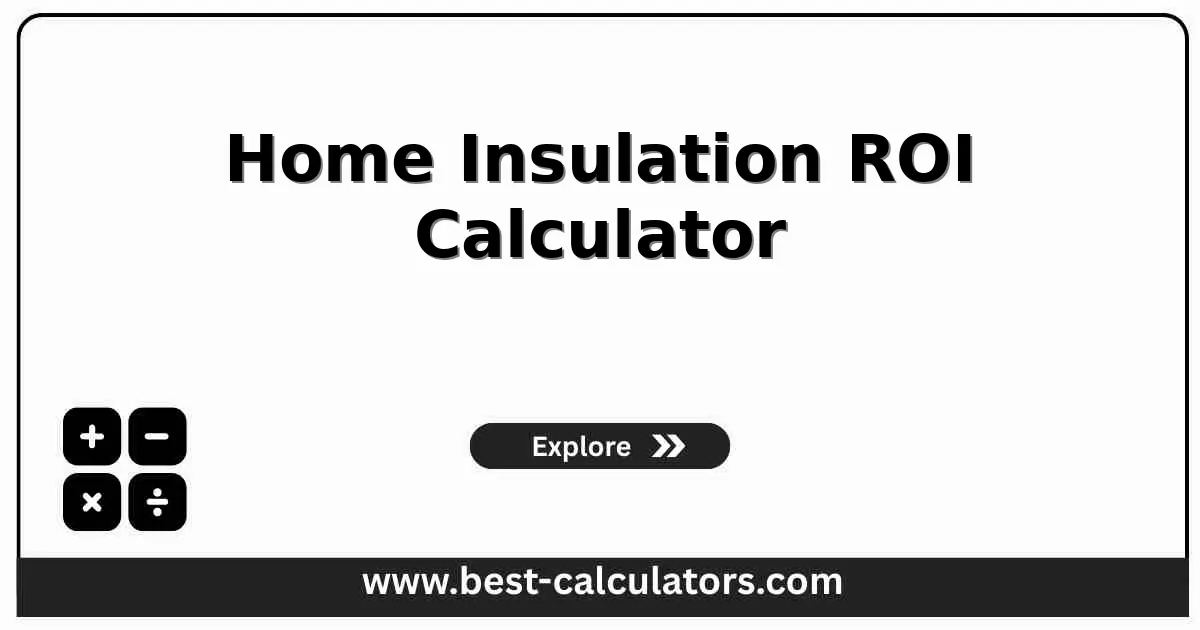Home Insulation ROI Calculator
Calculate insulation installation costs, annual energy savings, payback period, and return on investment for home efficiency upgrades
Insulation Project Inputs
ROI Results
What is a Home Insulation ROI Calculator?
A Home Insulation ROI Calculator estimates the return on investment for adding or upgrading insulation in attics, walls, floors, and crawl spaces. It calculates installation costs, annual energy savings from reduced heating and cooling, payback period, and long-term financial returns to help homeowners prioritize efficiency upgrades.
This calculator evaluates:
- Installation costs - Material and labor expenses by area and R-value
- Energy savings - Reduced heating and cooling costs annually
- Payback period - Years to recover investment through savings
- ROI - Percentage return over 10-20 year analysis period
- Environmental impact - CO₂ reduction and energy conservation
To calculate overall home energy consumption before insulation upgrades, use our Home Energy Audit Calculator to identify high-priority efficiency improvements beyond insulation.
For comprehensive HVAC efficiency analysis after insulation, try our Energy Star Appliance Savings Calculator to evaluate furnace and AC upgrades alongside insulation.
To calculate solar panel installation for offsetting remaining energy use, check our Solar Panel Savings Calculator for renewable energy ROI after reducing consumption through insulation.
How Insulation ROI Calculator Works
The calculator uses building science and energy modeling:
= ((1/R-current) - (1/R-new)) ÷ (1/R-current) × 100%
= Area × Heat Loss Reduction × (Heating Cost + Cooling Cost)
• Attic: $1.50-2.50/sq ft (R38-R60)
• Walls: $2.50-4.00/sq ft (blown-in)
• Crawl space: $1.50-3.00/sq ft
= Total Installation Cost ÷ Annual Energy Savings
= ((Total Savings - Installation Cost) ÷ Installation Cost) × 100%
Recommended R-values vary by climate: cold climates need R49-R60 attic insulation, while hot climates require R38-R49. Walls typically need R13-R21 depending on climate zone.
Air sealing provides 5-15% additional savings by preventing infiltration around doors, windows, outlets, and penetrations. Often the best ROI improvement (300-500% return).
Key Insulation Concepts
R-Value
Measures thermal resistance—higher R-value means better insulation. R-value adds: R15 + R20 = R35 total. Climate determines recommended R-values (DOE Zone Map).
Air Sealing First
Seal air leaks before adding insulation for best results. Air sealing alone saves 10-20% on HVAC costs. Use caulk, weatherstripping, and spray foam for gaps and cracks.
Thermal Bridging
Wood studs conduct heat, reducing wall insulation effectiveness by 20-30%. Continuous insulation or advanced framing minimizes thermal bridging losses.
Moisture Management
Vapor barriers prevent moisture damage in cold climates. Improper installation causes mold, rot, and insulation failure. Ensure proper ventilation and barrier placement.
How to Use This Insulation Calculator
Measure Insulation Areas
Calculate attic floor area, exterior wall area, and crawl space area. Use building plans or measure directly. Focus on largest, least-insulated areas first.
Check Current R-Values
Inspect attic to measure existing insulation depth. 1 inch fiberglass ≈ R2.5-3.5, cellulose ≈ R3-4. Walls typically R11-R15 if insulated, R0-R5 if empty.
Input Annual Energy Costs
Check utility bills for annual heating and cooling expenses. Separate gas/oil heating from electric AC costs. Higher costs = better insulation ROI.
Select Upgrade Areas
Choose which areas to insulate based on current condition and accessibility. Attic is easiest and highest ROI. Walls require professional installation.
Review ROI & Payback
Compare payback period to project budget. Projects under 10 years are excellent investments. Consider utility rebates (often $100-1,000) to improve ROI.
Benefits of Home Insulation
- • Reduce Energy Bills: Save 15-30% on heating and cooling costs ($200-600 annually). Attic insulation alone reduces energy bills by 10-15% in most climates.
- • Improve Comfort: Eliminate cold floors, drafty rooms, and temperature fluctuations. Maintain consistent temperatures throughout home year-round.
- • Increase Home Value: Well-insulated homes sell faster and command 3-5% higher prices. Energy efficiency is top buyer priority in most markets.
- • Reduce HVAC Wear: Less runtime extends furnace and AC lifespan by 3-5 years. Smaller HVAC systems needed for properly insulated homes.
- • Environmental Impact: Prevent 2,000-4,000 lbs CO₂ emissions annually. Reduce energy consumption by 20-40% compared to uninsulated homes.
- • Noise Reduction: Insulation dampens exterior noise by 30-50%, creating quieter indoor environment. Particularly effective for walls and attics.
Factors That Affect Insulation ROI
1. Climate Severity
Extreme climates (very cold or very hot) provide faster payback through greater savings. Moderate climates have longer payback periods (8-15 years vs 3-7 years).
2. Energy Prices
Higher electricity, gas, or oil costs improve ROI proportionally. At $0.20/kWh vs $0.10/kWh, payback period is 50% shorter. Expect prices to rise over time.
3. Current Insulation Level
Upgrading from R0 to R30 provides massive savings. R15 to R30 improves efficiency 15-25%. Diminishing returns above recommended R-values for climate.
4. Installation Method
DIY attic insulation costs 40-60% less than professional but requires proper technique. Spray foam (professional only) costs 2-3x more but provides air sealing and highest R-value per inch.

Frequently Asked Questions
How much can I save with better home insulation?
Proper insulation saves 15-30% on heating and cooling costs, averaging $200-600 annually for a typical home. Attic insulation alone can reduce energy bills by 10-15%, with payback periods of 2-7 years.
What is the best ROI for home insulation upgrades?
Attic insulation offers the best ROI (200-400%) with 2-4 year payback. Air sealing provides 300-500% ROI. Wall insulation has longer payback (7-12 years) but adds 5-10% to home value.
What R-value insulation do I need?
Recommended R-values vary by climate and location: attics R38-R60, walls R13-R21, floors R25-R30, crawl spaces R25. Check Energy Star recommendations for your climate zone (Department of Energy Zone Map).
How long does home insulation last?
Fiberglass and cellulose insulation lasts 80-100 years if properly installed and protected from moisture. Spray foam lasts indefinitely. Settling reduces effectiveness 2-5% over 20 years for blown insulation.
Can I install insulation myself or need a professional?
DIY attic insulation (batts or blown) saves 40-60% on installation costs. Professionals recommended for walls, spray foam, and air sealing (requires blower door testing). Many utilities offer free energy audits and rebates.